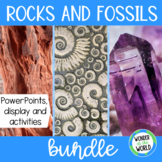How a fossil is formed sequencing cards and foldable cut and paste activity
- Zip
What educators are saying
Products in this Bundle (3)
Also included in
- This bundle of resources is packed full of information about rocks and fossils including a rocks display, fossil activities, and PowerPoints. Ideal to support an elementary geology or earth science unit. Resource 1 - Rocks Classroom Display8 rock example photos (granite, chalk, sandstone, flint, marPrice $10.00Original Price $17.50Save $7.50
- Excite and engage your students with facts and information about fossils with this activity and presentation bundle. This earth science set of resources covers how fossils are formed, what they can tell us, fossil examples, and more!Resource 1 - A-Z Rocks and Fossils Google Slides presentation ConsoPrice $8.25Original Price $14.50Save $6.25
Description
Teach or review the stages of how fossils form with these ammonite fossil activities. There are 2 resources in this mini-bundle - a set of illustrated cards showing how an ammonite became a fossil and a foldable activity.
A bonus word search freebie is also included.
How a fossil is formed foldable activity
This foldable sequencing activity will help students recall 6 stages of fossilization in a fun and engaging way, that's more hands-on than a standard fossils worksheet.
The templates
There are 4 similar PDF templates to choose from for this foldout activity:
1. Color the images, cut out and fold.
2. Color the images, cut out the words and sequence them, glue the words in place, cut and fold.
3. Color the images, cut out the words with the pictures and sequence them, glue the words in place, cut and fold.
4. Larger version of template 3 (set over 2 pages).
When closed, you'll just see the large fossil ammonite but when opened, the fossilization process will be revealed! You can see a finished example in the preview. This activity is ideal to use as a science center, for an interactive science notebook or for an earth science lesson on fossil formation.
Instructions for students are provided (including a picture showing how to fold) as well as some questions for a whole class discussion. Some suggested answers are provided for this.
Stages of fossilization sequencing cards
Order the stages of fossilization with this printable sequencing activity. This resource uses the example of an ammonite (a marine creature with a spiral-shaped shell) to explore 8 steps in the fossilization process. Laminate to use as a science center again and again.
This resource includes:
- Teacher notes
- 8 fossil sequencing cards (2 to a page) in color without text.
- 8 fossil sequencing cards (2 to a page) in color with a short description on each card.
- 8 fossil sequencing cards (2 to a page) in black and white without text.
- 8 fossil sequencing cards (2 to a page) in color with a short description on each card.
- Labels to print and use with the card sets that don't have text.
- 8 fossil sequencing cards (4 to a page) in black and white without text.
The PDF is not editable. Uk and US paper sizes included.







